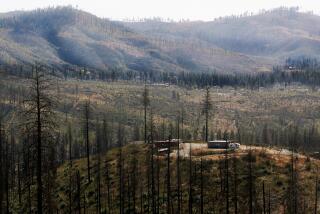Weather and the winds of change
- Share via
THE most memorable glacier I’ve seen is in Nevada, on the northeast side of 13,063-foot Wheeler Peak in Great Basin National Park near the Utah border. I’ve seen bigger glaciers. I’ve even been inside one in Alaska, in an ice cave with translucent blue walls and shadowy pools that seemed like something out of a Wagner opera. But none impressed me as much as the one in Nevada.
Like most, the Wheeler Peak glacier lies in a beautiful cirque, a shining sweep of cliffs and scree. The fact that it is the only glacier in the Great Basin adds to its effect, as does getting to it from California, a trip on some of the loneliest roads in America. Mile after mile of sagebrush or saltbush flats, broken only by narrow mountain ranges sprinkled with junipers and pinyon pines, hardly prepares you for the sight ahead, especially in mid-summer.
As I puffed up the scree toward the glacier, head throbbing from the altitude, I felt a sense of otherworldliness. Even ravens, ordinary as pigeons in town nowadays, seemed surreal as they croaked and soared over the cliffs. But what made this hike memorable was not so much the glacier itself.
I’d wanted to go to Wheeler Peak to see the bristlecone pines, celebrated as among the most long-lived trees (if not the most). I had assumed from their reputation that they only grew above timberline, and I expected to see only a few gnarled, dwarfed, half-dead trees hanging on in isolation or in scattered groups. But it wasn’t that simple.
In the forest lower down -- a forest unlike any I’d seen -- I found bristlecones growing straight and tall with the Engelmann spruce and limber pines. In fact, bristlecones actually grow bigger than some other pines, 60 feet tall and 2 feet in diameter, and like most conifers at that elevation, they are not particularly long-lived (about 400 years at the most).
Above timberline, the trees live longer because the harsh conditions slow their metabolisms, and because the wood has a high resin content, it is less susceptible to parasites and disease. At these higher elevations, white bark, limber and foxtail pine also survive as gnarled, dwarfed specimens; they just don’t live as long.
Seeing the bristlecones growing as “normal” forest trees was a revelation. During the ice age, a forest of bristlecone, limber pine and spruce grew all across the Great Basin, except of course in basins flooded by enormous lakes or on slopes covered by montane glaciers. A trip across Nevada would have been mainly by boat, with portages through forests.
I’ve been looking at these ancient lake beds ever since I first drove across Nevada more than 30 years ago, but the ice age landscape never seemed as real as when I saw those straight bristlecones growing in the forest under Wheeler Peak.
After walking through that forest with the glacier in sight, I got a sense of how different the world can be from what we think of as normal and of how quickly normal can become strange.
There’s a lot of evidence of how much the landscape has changed in the 10,000 years since the last ice age. Pine debris exists in ancient packrat nests far from today’s trees. Where U.S. 50 crosses are old lake beds, concentric rings on surrounding mountains show how ancient lake levels rose and fell thousands of years ago.
What we don’t know is how long it took for these lakes and forests to be reduced to sagebrush flats, and what is less clear are the reasons for the change. A cooler, wetter climate created the glaciers, lakes and forests, but nobody really knows -- despite an abundance of theories ranging from shifting ocean currents to our solar system’s position in the galaxy -- what caused this cooler, wetter climate.
Could Nevada be underwater again in the foreseeable future? It seems counterintuitive to suggest it, given the trend toward global warming. As the arid belt above the Tropic of Cancer shifts north, the climate will more likely become drier and the Wheeler Peak glacier will disappear.
On the other hand, global warming might have other effects. Nevada’s climate might conceivably become wetter if warmer weather influences precipitation in unexpected ways.
But there is no way of knowing. If such incredible disparities exist between today’s dry landscape and yesterday’s flooded one, do we even have the ability to imagine what lies ahead, between today and a much warmer future?
More to Read
Sign up for The Wild
We’ll help you find the best places to hike, bike and run, as well as the perfect silent spots for meditation and yoga.
You may occasionally receive promotional content from the Los Angeles Times.






